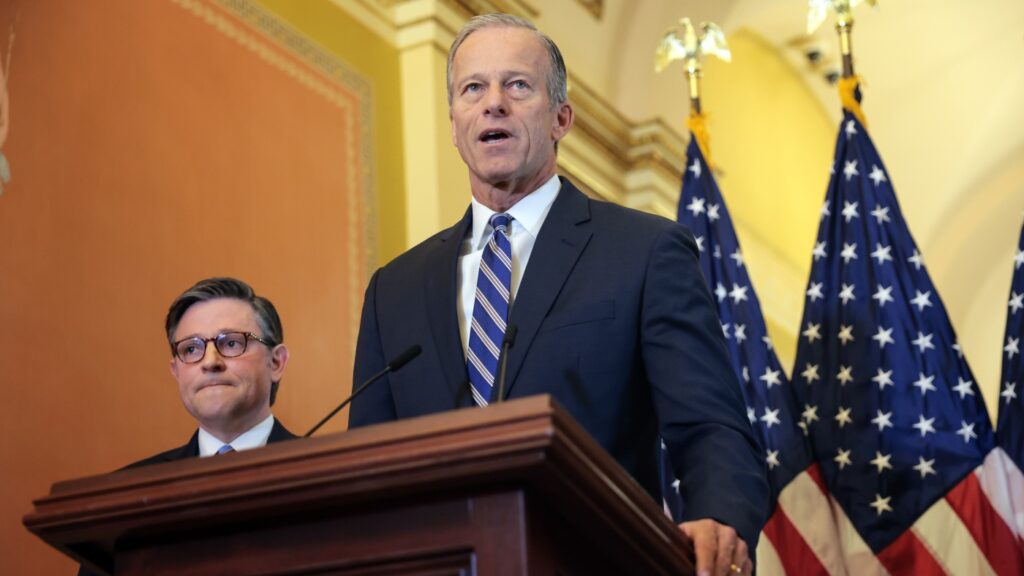
WASHINGTON, DC - APRIL 10: U.S. Senate Majority Leader John Thune (R-SD) (R) and Speaker of the House Mike Johnson (R-LA) hold a press conference on the Republican budget bill at the U.S. Capitol on April 10, 2025 in Washington, DC. The Republican leaders spoke on the reconciliation process and said they would find $1.5 trillion in cuts as the House prepares to vote on President Trump's budget outline for his tax and spending plan after Republican holdouts refused to vote without deeper cuts. (Photo by Kayla Bartkowski/Getty Images)
WASHINGTON, D.C. – Senate Republicans have unveiled an updated version of their sweeping spending and tax cut legislation, which encapsulates much of former President Trump’s domestic agenda. The bill is set to be voted on imminently, with the GOP aiming to meet their self-imposed July 4 deadline.
Breaking: Key Provisions of the GOP Megabill
The revised bill retains several core policies that narrowly passed in the House of Representatives in May. These include an extension of the 2017 tax cuts, alongside increased funding for border security, defense, and energy production. Republican leaders are pushing for votes to commence on Saturday, with an open-ended amendment process that could extend into Sunday, potentially altering the bill further.
Key Statistic: The Senate is proposing to raise the nation’s debt ceiling by $5 trillion, surpassing the House’s $4 trillion proposal.
Immediate Impact and Division
While the Senate bill mirrors the House’s in many respects, it introduces significant changes, particularly concerning the debt limit and Medicaid. The Senate’s proposal features a higher debt ceiling increase and substantial Medicaid adjustments, which have sparked internal party conflicts.
Senator Rand Paul of Kentucky has pledged to oppose the bill due to concerns over the borrowing limit. The bill’s fate in the House remains uncertain, given the slim Republican majority and differing priorities among GOP members.
Key Details Emerge
The Senate version includes temporary tax incentives such as deductions for tip wages and overtime pay, with income limits not present in the House bill. It also proposes a permanent expansion of the standard deduction and an increase in the child tax credit, differing from the House’s temporary measures.
By the Numbers: The child tax credit would increase from $2,000 to $2,200 per child, with inflation adjustments post-2025.
Industry Response to SNAP Changes
The bill proposes reforms to the Supplemental Nutrition Assistance Program (SNAP), extending work requirements and shifting cost burdens to states. These changes are set to take effect in 2028, aligning with other long-term provisions in the bill.
Medicaid and Healthcare Adjustments
Significant changes to Medicaid include work requirements for able-bodied adults and a cap on state-imposed taxes on Medicaid providers. These provisions have raised concerns about potential impacts on rural hospitals, prompting the inclusion of a $25 billion fund to support these facilities.
Important Quote: “We have about a dozen members that are voting on this bill exclusively based on what happens with SALT,” said House Majority Leader Steve Scalise, R-La.
Background Context and Legislative Journey
The bill’s journey has been fraught with negotiations and revisions. Senate Parliamentarian Elizabeth MacDonough has played a crucial role in ensuring the bill’s compliance with reconciliation rules, leading to the removal of several provisions.
The state and local tax deduction (SALT) remains a contentious issue, with the Senate plan proposing a temporary lift of the cap to $40,000 for certain couples, expiring after 2028.
What Comes Next
The Senate’s decision will significantly influence the bill’s trajectory, with the House needing to reconcile any differences. The outcome could reshape fiscal policy and social programs for years to come.
As the Senate prepares for votes, the political and economic implications of the GOP megabill remain a focal point of national debate, with potential repercussions extending well beyond the legislative chambers.







